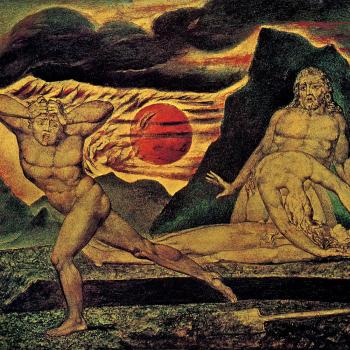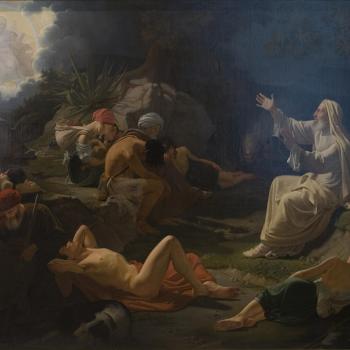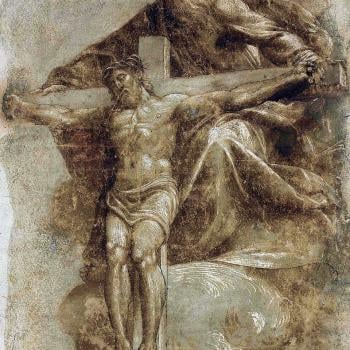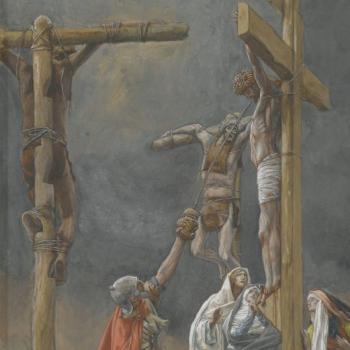
A living hope is a dangerous thing. It is a revolutionary thing. Hope can keep you going when you’re in solitary confinement, when you’re being pressed down and spit out of society’s mouth, when you lose someone so dear to you it makes you want to die every day.
Consider the theme of hope in Shawshank Redemption. Andy, Red, and other prison inmates are talking about Andy’s recent two-week long isolation in solitary confinement (you can find the link to the scene here). Andy shares that he relied on classical music playing in his head and heart to keep him from going crazy. He speaks of how hope keeps him going in prison, to which Red retorts that “Hope is a dangerous thing” and can drive someone insane when they’re imprisoned. Perhaps so. But despair can also drive you crazy or perhaps kill your spirit long before your body dies. Later, in the end, Red realizes that Andy’s words are true: “hope is a good thing, maybe the best of things, and no good thing ever dies.” Hope is one of the greatest tools people have at their disposal to chisel and dig and break out of the jail of despair and experience life. Like Red, we all have the choice before us to “get busy living or get busy dying.” Red decides to keep living and reunites with Andy at the ocean.
How can we activate hope in the midst of turbulence, despair, depression, and despondency? Where do you look for hope and encouragement in very turbulent times? Certainly, music can play a pivotal role, as in the case of Andy who was accompanied by “Mr. Mozart” in solitary confinement. So, too, can friendship. Andy’s friendship with Red helped to sustain him, as well as Red. Stories of hope also speak to us, including the tale of Shawshank Redemption. Stephen King’s story may be fictional, but fiction of this quality speaks to the reality of our deepest aspirations embedded in our souls and loftiest ideals soaring in our imaginations.
Similarly, one of my strategies when facing such threats is to look to stories of various real-life people who have faced overwhelming odds and have overcome those obstacles with hope. My sister Nancy is one of those people. She lost her beloved daughter Hannah to leukemia many years ago. But Hannah still lives in so many ways, including in my sister’s will to live and love with the same ferocious tenacity and vibrancy of Hannah. Her conviction that Hannah is even now with her, that they are together in the heart of God, and that she will see her again, moves her forward with hope.
Who isn’t moved by stories of people who have overcome incredible obstacles in life to accomplish great things, which includes doing the Herculean work of striving to live with hope each day in the face of the temptation to despair? It could be an escape from the prison of poverty or depression or physical incapacities or failure or rejection. Hope kept them going. Hope is worth the risk, no matter what the challenges are along the way. What’s the alternative? Despair? Despair signifies finality. But a living hope is never over. It is never dead.
Several weeks ago, my wife, daughter, and I were eating dinner. We were talking about how hard it can be at times to keep pressing on amid all that has transpired involving my son Christopher’s catastrophic brain injury. Not only was the brain injury global, but so, too, is its impact in every area of life. Faced with the threat of despair, my wife interjected a statement that was a turning point in the conversation: “Living in despair means living in conclusion.” The story is not over. Far from it.
Fyodor Dostoyevsky writes about this theme of despair and living in conclusion in The Idiot. The principal character Prince Myshkin is discussing execution by the guillotine in France. He believes it is far better to look down at the barrel of a cannon on a battlefield than to have one’s head locked into place in the guillotine and await the falling, slicing blade. Prince Myshkin claims that worse than any pain from wounds or torture is the certainty of death: “And yet the chief, the strongest pain may not be in the wounds, but in knowing for certain that in an hour, then in ten minutes, then in half a minute, then now, this second—your soul will fly out of your body and you’ll no longer be a man, and it’s for certain—the main thing is that it’s for certain. When you put your head under that knife and hear it come screeching down on you, that one quarter of a second is the most horrible of all.” (23)
Prince Myshkin had observed capital punishment. Similarly, Dostoyevsky had been sentenced to capital punishment, but avoided that fate. Instead, he was sent away to labor in exile in Siberia for several years. Like the prince, Dostoyevsky suffered from epilepsy. He endured great suffering and the loss of loved ones, which is reflected in his writings. I doubt he would have been the masterful writer he became apart from suffering. As one of his characters says in Crime and Punishment, “Pain and suffering are inevitable for persons of broad awareness and depth of heart. The truly great are,…, always bound to have a great sense of sadness during their time upon earth.” (315) In this novel, too, Dostoyevsky reflects on the theme of how horrific it is to endure the certainty of an approaching death. The person condemned to this inevitable fate would rather live forever in small quarters on a high rock on a precarious ledge surrounded by eternal isolation blanketed by darkness and beaten by storms, than to endure this ominous sense of finality. To live, no matter the overwhelming challenges, is always better than to endure the impending and irreversible closure to life (Crime and Punishment, 191).
And what about those times when the inevitability and certainty of death is pressed upon us, where there is no more mountain ledge to stand on, where the finality of this mortal life has arrived. Even then, the end is not final. Here I turn from one master of literature who knew grief and suffering to another literary giant who had also experienced great pain. Charles Dickens’ A Tale of Two Cities includes an account of one man sacrificing himself for another to the certain fate of the guillotine’s blade during the French Revolution. Englishman Sydney Carton sacrifices himself for Frenchman Charles Darnay. Carton does so for Darnay so he can be reunited with his wife and child. Carton, who bears a striking resemblance to Darnay, cunningly exchanges clothes and changes places with Darnay in his prison cell, as he awaits execution. Carton redeems his own derelict life and infuses it with resurrected meaning by sacrificing himself for Darnay and his family. As Carton approaches the guillotine, he quotes from John 11: “’I am the resurrection and the life,’ saith the Lord.” In fact, he quotes or alludes to that Scripture on several occasions in Dickens’ narrative. Carton also says,
I see a beautiful city and a brilliant people rising from this abyss. I see the lives for which I lay down my life, peaceful, useful, prosperous and happy. I see that I hold a sanctuary in their hearts, and in the hearts of their descendants, generations hence. It is a far, far better thing that I do, than I have ever done; it is a far, far better rest that I go to than I have ever known.
Hope in the resurrected Lord Jesus who will raise the dead inspires Carton. Hope beyond the grave inspired two real-life figures, Martin Luther King, Jr. and Dietrich Bonhoeffer. They knew death was inevitable due to their lives of sacrifice on others’ behalf. King was assassinated with a bullet and Bonhoeffer was hanged in the gallows. But King also knew and loved to declare, that while the moral arc of the universe is long, it bends toward justice, that the cross is the scaffold that hangs history, and that Friday’s here but Sunday’s coming. And Bonhoeffer knew that though his time had come, he was just getting going. It has been recounted that shortly before his death, Bonhoeffer asserted: “This is the end—for me, the beginning of life.” Bonhoeffer and King both died at the age of 39. But they live on with the resurrected Lord and in history through their legacy of faith, hope, and love.
No doubt, Bonhoeffer and King took to heart the reality of Peter’s message in 1 Peter 1: theirs is a living hope. Peter writes:
Praise be to the God and Father of our Lord Jesus Christ! In his great mercy he has given us new birth into a living hope through the resurrection of Jesus Christ from the dead, and into an inheritance that can never perish, spoil or fade. This inheritance is kept in heaven for you, who through faith are shielded by God’s power until the coming of the salvation that is ready to be revealed in the last time. In all this you greatly rejoice, though now for a little while you may have had to suffer grief in all kinds of trials. These have come so that the proven genuineness of your faith—of greater worth than gold, which perishes even though refined by fire—may result in praise, glory and honor when Jesus Christ is revealed. Though you have not seen him, you love him; and even though you do not see him now, you believe in him and are filled with an inexpressible and glorious joy, for you are receiving the end result of your faith, the salvation of your souls. (1 Peter 1:3-9; NIV)
Peter made this declaration against the backdrop of the Roman Empire pressing down on the fledgling Christian movement and trying to spit Jesus’ followers out of society’s mouth. The living hope in Jesus signifies that our inheritance never perishes, spoils, or fades. Shawshank Redemption’s Andy says, “No good thing ever dies.” To commandeer a few lines from T.S. Eliot, “What we call the beginning is often the end. And to make an end is to make a beginning.”
The New Testament declares that the seeming finality of death gives way to the beginning of eternity. Futility gives way to futurity. So, how do I live now in view of that reality here and now?
I always need to look for new beginnings. My son’s life as we knew it came to an end on January 21st, 2021. We lost Christopher as we knew him. There have been times where I have simply wanted to crawl into a cave, curl up in a ball, and die. The seeming finality of the despairing situation was so apparent. But as our medical consultant, palliative care specialist Robert Potter (M.D., Ph.D.), informed us after the second MRI, Christopher is a new creation who will grow in new ways. Yes, he is the same person, though so very different. Those words have helped us immeasurably over the past two years.
On Friday, we met with a neurologist. He is well-aware of how global Christopher’s injury was. We have stayed in touch with him for some time now. We shared our observations, and those of others, with him. Here is the assessment that came out of the appointment:
First, Christopher is experiencing some level of neuroplasticity.
Second, the full prognosis could be many years out and that given his youth, the more time we allow for recovery, the better. Along these same lines, healing does not necessarily grow or diminish with time. It’s more a matter of whether we see growth or a plateau over a significant period of time (like a year from now, for example).
Just think, if we had given in to despair early on and pulled the plug (as some medical personnel had intimated that we should do), there would not have been any neuroplasticity. Just think, if we had not advocated and stayed attentive, and if it were not for good caregivers, Christopher may have died due to aspiration pneumonia or pressure wounds. Just think, if we had thought that because Christopher’s life as we knew it had come to an end, there would be no opportunity for new beginnings. Just finality, no futurity.
Memory can help guard against the finality of despair. Remembering loved ones who have passed, recalling who they were before some horrible accident, can help. Remembering them, honoring their legacy by living in view of them to do good, not evil, knowing that even such finality gives way to futurity, is revolutionary.
Flexibility in our expectations in view of an open future can also pay huge dividends for living victoriously. Things never remain the same. We cannot go back to the way things were. But how can we live better, not bitter, in view of an open future of infinite possibilities? The story for each person is still unfolding, now and in eternity. Flexibility like neuroplasticity is essential. If we do not rewire in the face of tragedy, we will plateau, perhaps even die.
Good things like hope never die. No matter how tempting, never give in to despair. I, for one, will not allow futility to have the last word. How does that honor Christ or Christopher?
Hope is a dangerous thing. Living hope is revolutionary. It can bring much good out of evil. Living in despair means living in conclusion. But with living hope, futility gives way to futurity. The end is just the beginning.














